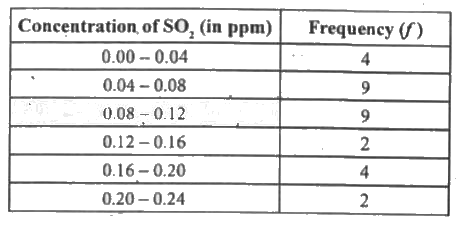A : High concentration of atmospheric SO2 reduces primary productivity.
R : SO2 converts the chlorophyll a into phaeophytin.
If both Assertion & Reason are true and the reason is the correct explanation of the assertion, then mark (1).
If both Assertion & Reason are ture but the reason is not the correct explanation of the assertion, then mark (2).
If Assertion is true statement but Reason is false, then mark (3).
If both Assertion and Reason are false statements, then mark (4).
The correct Answer is:A
To solve the question regarding the assertion and reason about the effects of sulfur dioxide (SO2) on primary productivity and chlorophyll, we will break it down step by step.
1. Understanding the Assertion:
- The assertion states that "high concentration of atmospheric SO2 reduces primary productivity."
- Primary productivity refers to the rate at which plants and other photosynthetic organisms produce organic compounds (like glucose) from carbon dioxide and water through photosynthesis. High levels of SO2 can negatively impact this process.
Hint: Recall that primary productivity is crucial for the energy flow in ecosystems and is primarily driven by photosynthesis.
2. Understanding the Reason:
- The reason states that "SO2 converts chlorophyll a into phaeophytin."
- Chlorophyll is the green pigment in plants that plays a critical role in photosynthesis. Phaeophytin is a form of chlorophyll that has lost its magnesium ion, which is essential for its function. The conversion of chlorophyll to phaeophytin can impair the plant's ability to photosynthesize effectively.
Hint: Consider the role of chlorophyll in photosynthesis and how its alteration can affect plant health and productivity.
3. Connecting Assertion and Reason:
- Both the assertion and reason are true. High levels of SO2 can lead to the conversion of chlorophyll into phaeophytin, which in turn reduces the plant's ability to carry out photosynthesis, thus lowering primary productivity.
Hint: Think about how the loss of chlorophyll function directly impacts the photosynthetic process.
4. Conclusion:
- Since both the assertion and reason are true, and the reason provides a correct explanation for the assertion, we can conclude that the correct option is that both assertion and reason are true, and the reason is the correct explanation of the assertion.
Hint: Look for the relationship between the two statements to determine if one logically explains the other.
Final Answer:
Both assertion and reason are true, and the reason is the correct explanation of the assertion.
- The assertion states that "high concentration of atmospheric SO2 reduces primary productivity."
- Primary productivity refers to the rate at which plants and other photosynthetic organisms produce organic compounds (like glucose) from carbon dioxide and water through photosynthesis. High levels of SO2 can negatively impact this process.
- The reason states that "SO2 converts chlorophyll a into phaeophytin."
- Chlorophyll is the green pigment in plants that plays a critical role in photosynthesis. Phaeophytin is a form of chlorophyll that has lost its magnesium ion, which is essential for its function. The conversion of chlorophyll to phaeophytin can impair the plant's ability to photosynthesize effectively.
- Both the assertion and reason are true. High levels of SO2 can lead to the conversion of chlorophyll into phaeophytin, which in turn reduces the plant's ability to carry out photosynthesis, thus lowering primary productivity.
- Since both the assertion and reason are true, and the reason provides a correct explanation for the assertion, we can conclude that the correct option is that both assertion and reason are true, and the reason is the correct explanation of the assertion.
Both assertion and reason are true, and the reason is the correct explanation of the assertion.
Topper's Solved these Questions
- ENVIRONMENTAL ISSUESBOOK - AAKASH INSTITUTE ENGLISHCHAPTER - ENVIRONMENTAL ISSUESEXERCISE - ASSIGNMENT SECTION C
92 Videos
- ECOSYSTEMBOOK - AAKASH INSTITUTE ENGLISHCHAPTER - ECOSYSTEMEXERCISE - Section - D (Assertion - Reasion Type questions)
15 Videos
- EVOLUTIONBOOK - AAKASH INSTITUTE ENGLISHCHAPTER - EVOLUTIONEXERCISE - TRY YOURSELF
29 Videos
Similar Questions
SO2 can reduce :
View SolutionA : High concentration of atmospheric SO2 and NO2 causes acid rain.
R : It causes damage to foliage and growing points of plant.
View SolutionAssertion : The higher concentration of O2 in the atmosphere is inhibitory to photosynthesis. Reason; Rubisco binds to oxygen at high partial pressure of oxygen
View SolutionWhen PCl5 reacts with SO2 products formed is/ are;
View SolutionWhat is the product when Mg react with SO2 ?
View SolutionSO2+12O2⇔SO3, for the above reaction, if 'a' and 'b' mole/1 are the initial concentrations of SO2andO2 respectively and x mole SO3 is formed at equlibrium. The equilibrium concentration of O2 will be
View SolutionAn alcohol (A) on heating with concentrated H2SO4 gives alkene (B) as major product and (B) can shown the geometrical isomerism . The compound (A) is :
View SolutionTo find out the concentration of SO2 in the air (in parts per million, i.e., ppm), the data was collected for 30 localities in a certain city Find the mean concentration of SO2 in the air.

View SolutionThe role of concentrated H2SO4 in the esterification process is :
View SolutionAn inorganic Compound (A) has garnet red prismatic crystals. (A) is modertely soluble in water and dissolved in cold concentrated H_(2)SO_(4) to yield red crystal (B) . In presence of dilute H_(2)SO_(4) it converts a pungent gas (C ) into yellow turbidity (D) and converts a Suffocating gas (E) into a green solution (F). the gas (C ) and (E) also combine to produced the yellow turbidity (D) . With KI and starch in presence of dilute. H_(2)SO_(4) (A) and concentrated H_(2)SO_(4) Mixture used as a cleansing agent for glassware in the laboratory . identify (A) and explain the reactions.
View Solution
